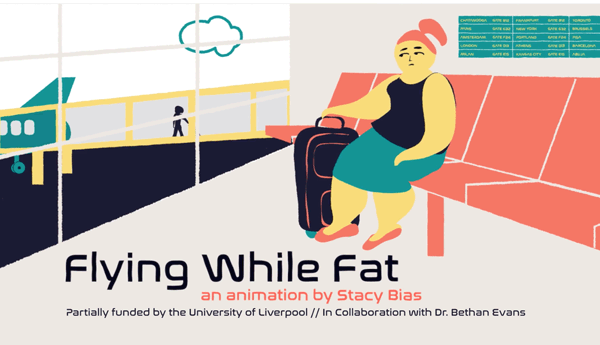The Obesity Action Coalition: Busting the Bias of “Bias Busters”

 The essay below was written for my Representation & Textual Analysis course at Goldsmiths, University. The main purpose of the essay is to show my understanding of myth-based semiotic analysis – thus it’s not really written in the conversational style I’d normally use for a blog post. I waited a couple of weeks to publish it here because I didn’t want to be accused of plagiarizing myself. ;) But now that the coursework is all done and dusted, I’m sharing it because I hate the OAC and the stupid, smug, capitalizing horse it rode in on.
The essay below was written for my Representation & Textual Analysis course at Goldsmiths, University. The main purpose of the essay is to show my understanding of myth-based semiotic analysis – thus it’s not really written in the conversational style I’d normally use for a blog post. I waited a couple of weeks to publish it here because I didn’t want to be accused of plagiarizing myself. ;) But now that the coursework is all done and dusted, I’m sharing it because I hate the OAC and the stupid, smug, capitalizing horse it rode in on.
—————————–
In the legitimizing form of a press release, the Obesity Action Coalition (OAC) recently announced its intention to form an initiative to “combat weight bias and stigma.” (Zervios, 2011) The release highlights the OAC’s commitment to engaging the public in an awareness-raising dialogue regarding weight bias and stigma by presenting news and media examples each month and inviting the public to respond. While it is difficult to argue with the mission of eradicating prejudice, the OAC’s approach undermines its own stated purpose by omitting relevant truths and by further naturalizing harmful myths regarding its supposed underdogs, the obese. As well, through positioning itself as a champion against stigmatization, the OAC attempts to create an alibi of trustworthiness for its unspoken agenda, the legitimization of its bariatric (weight-loss) surgery advocacy. In this essay I will shed light on the OAC’s appropriation and introduction of myth to further its cause.
As stated by Roland Barthes (1984: 26), “myth is a type of speech defined by its intention … much more than by its literal sense.” By peppering the text of their press release with phrases such as “individuals affected by obesity”, by painting fat individuals as “bullied” and “targets”, and by choosing an authoritative tone that speaks for rather than with fat individuals, the OAC’s underlying intention is to ally these significations with the signifier of the fat individual, thus creating a larger connotation of passivity; the fat individual as a member of a downtrodden subculture, incapacitated by “disease” and helpless in the daily fight against their own oppression. Once these associations are created, the myth of the ineffectual fat individual gives the OAC the perfect platform from which to position itself (as signifier) the trustworthy defender (the signified).
The OAC further naturalizes the already virulent myth of fat people as unquestionably unhealthy by stating as-if fact “the debilitating effects of obesity” and, thus, capitalizes on that assumption of poor health to add credibility to its portrayal of defenselessness. A recent study (Kuk, 2011) shows that fat individuals who are otherwise healthy have no higher risk of mortality than those who are thin. Omitting this as a possibility and casting all fat individuals in the same sallow light of sickliness empties the fat-individual-as-signifier not only of power but also of a right to a personal history of health.
As stated by Barthes, “When it becomes form, the meaning leaves its contingency behind; it empties itself, it becomes impoverished, history evaporates, only the letter remains.” (1984: 5) If, then, the tactic of myth is to empty the signifier of history in order to fill it with its own meaning, the OAC employs this technique as the prevailing function of this press release to rob the fat individual of her agency. Fat groups and individuals have been advocating for themselves with their own powerful movement called Fat Liberation since the 1960s. With organizations like the Fat Underground, the National Association to Advance Fat Acceptance (NAAFA), and the Association for Size Diversity and Health (ASDAH) as well as publishing academics (Rothblum and Solovay, 2009), individuals campaigning for equal access to health insurance in the United States, for non-discrimination in the workplace (Solovay, 2000), and for social equality and empowerment (Wann, 1998), fat culture is not without a radical political history nor is it without its own league of champions and advocates. What the OAC’s press release omits by positioning itself as the heroic rescuer of a passive and defenseless community is a rich history of self-advocacy and determination. The OAC’s approach appropriates and renders invisible four decades of language, research, and socio-political progress.
The OAC further omits the contribution of the weight loss industry (of which it is a participant) in the creation of the very stigma that it claims to seek to eradicate. A recent study indicates a growing concern about the ethics of a weight focused paradigm as “not only ineffective at producing thinner, healthier bodies, but also damaging, contributing to food and body preoccupation, repeated cycles of weight loss and regain, distraction from other personal health goals and wider health determinants, reduced self-esteem, eating disorders, other health decrement, and weight stigmatization and discrimination.” (Bacon, 2011: 1) Joe Nadglowski, OAC President and CEO, is also the Executive Director of the American Society for Metabolic and Bariatric Surgery (ASMBS), the stated purpose of which is to “improve public health and well-being by lessening the burden of the disease of obesity.” Further, all additional members of the board of the OAC are also bariatric doctors, nurses or related professionals with titles such as “Is Weight Loss Surgery Right for You?” (Goldberg, 2006), “Weight Loss Surgery: Finding the Thin Person Hiding Inside You!” (Thompson, 2003) and “Weight Loss Surgery for Dummies” (Kurian, 2005) under their belts.
If these are the myths—the fat individual as passive/weak/helpless, the fat individual as debilitated and in poor health, the fat individual as requiring outside intervention to achieve health and happiness, the fat individual as without agency or history, the fat individual as all of the above and singularly representative of the whole—then a simple examination of the authors of this press release clearly reveals their motivation. The intention, it would seem, is not to eradicate weight bias and stigma but to eradicate the status of obesity from the individuals themselves. The method by which the OAC seeks to achieve this is through the recommendation of expensive, controversial bariatric surgeries that the members of its board perform for profit without regard to the fact that they have not been proven to create any long-term reduction in mortality (JAMA, 2011). The purpose of the outlined mythemes then becomes to first disempower their fat constituents and then to gain their trust in order to more convincingly recommend bariatric surgery, as stated in another OAC publication, as the “only treatment for morbid obesity proven to be consistently effective.” (Rogula et al, 2011)
The use of myth-based semiotic analysis to critically examine the OAC press release reveals their effective though unethical use of myth in attempts to naturalize the connotations of fat individuals as a signifiers of weakness, debilitation, constant victimization, passivity and ill-health. The OAC’s further use of myth to signify itself as heroic interventionist serves to both protect the otherwise obvious agendas of its board members from further scrutiny and to solicit the trust of its target audience and in turn legitimize its advice regarding bariatric surgery.
References:
Bacon, L., & Aphramor, L.,Weight science: evaluating the evidence for a paradigm shift. Nutrition journal, 10(1), (2011): 9. BioMed Central Ltd. doi:10.1186/1475-2891-10-9
Barthes, R., Mythologies. New York: Hill and Wang, 1972. 1-26.
Brolin, R., Bariatric surgery and long-term control of morbid obesity. JAMA : the journal of the American Medical Association, 288(22), (2002): 2793-6. Retrieved from http://www.ncbi.nlm.nih.gov/pubmed/12472304
Obesity Action Coalition., Educating and Advocating For All Those Affected by Obesity, Morbid Obesity and Childhood Obesity: 2006 Annual Report, Obesity Action Coalition. Surgery. November 7, 2011, <http://www.obesityaction.org/aboutus/annualreports/2006 Annual Report.pdf>
Goldberg, G., Is Weight Loss Surgery Right For You?, Eight Stories To Help You Decide. iUniverse, 2006. Print.
Kuk, J., Ardern, C. I., Church, T. S., Sharma, A. M., Padwal, R., Sui, X., & Blair, S. N., Edmonton Obesity Staging System : association with weight history and mortality risk. Applied Physiology, Nutrition, and Metabolism, 36(4), (2011): 570-576. doi:10.1139/H11-058
Kurian, M. S., Thompson, B., Davidson, B.K., Weight Loss Surgery For Dummies. For Dummies, 2006. Print.
Maciejewski, M. L., Livingston, E. H, Smith, V.A., Kavee, A.l., Kahwati, L.C., Henderson, W.G., Arterburn, D.E., Survival Among High Risk Patients After Bariatric Surgery, JAMA : the journal of the American Medical Association, Published online June 12, 2011. doi: 10.1001/jama.2011.817
Rogula, T., Brethauer, .S, Chand, B., Schauer,P., “Bariatric Surgery as a Treatment for Type 2 Diabetes”, Obesity Action Coalition, November 7, 2011 <http://www.obesityaction.org/magazine/oacnews11/diabetesandsurgery.php>.
Rothblum, E., Solovay, S., Fat Studies Reader. 1st ed. New York: NYU Press, 2009. Print.
Solovay, S., Tipping The Scales Of Justice, Fighting Weight-based Discrimination. 2000. Print.
Thompson, B., Weight Loss Surgery, Finding The Thin Person Hiding Inside You!. Word Assn Pub, 2003. Print.
Wann, M., Fat! So?, Because You Don’t Have To Apologize For Your Size!. Ten Speed Pr, 1999. Print.
Zervios , J., “Obesity Action Coalition (OAC) Unveils “Bias Busters” to Combat Weight Bias and Stigma”, Obesity Action Coalition, November 7, 2011 <http://www.obesityaction.org/news/2011/biasbusters.php>.




June 7, 2014 at 8:47 pm
Dagny Kight
This cracked me up! I used to go troll around the OAC Facebook page when they’d post one of their “Bias Busters” petitions that maybe a hundred people would sign. They would post the DUMBEST shit. I don’t know what they raise money for or what they actually do. I get the ASMBS as every medical specialty has its own society. But I really can’t guess what the people at OAC do all day.
I will add that I am pro-choice on weight loss surgery. It’s a personal healthcare choice.
November 19, 2011 at 11:18 am
BigLiberty
Stacy, this was very well-written and clear. Your use of references was judicious and your conclusions reasonable. Well done!
Here’s a question (I’m not sure if you have an answer): are there any anti-obesity groups out there that aren’t connected in some part to special interests that want to profit from fat discrimination and fat=ill health myths out there? Even government groups usually have a vested interest, typically in capitalizing on fat discrimination to use fat people as scapegoats for broken or failing policies.
November 20, 2011 at 6:13 am
Stacy Bias
I am afraid I haven’t done enough research to answer your question, Big Liberty. It certainly seems unlikely – though my guess is that some (like the OAC) are profiting less subtly than others. There’s an article that came out this week here in the UK about a government anti-obesity taskforce that was disbanded. The politics of disbanding it, however, were not at all based in greater understanding about the negative impacts of anti-obesity rhetoric but more in a locking of horns between differing special interest groups. It’s ridiculous.